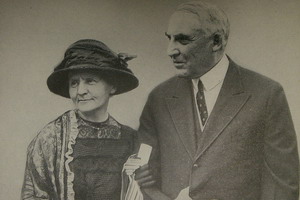 “Madame Curie” has influenced the history of physics and chemistry, but also the applied natural sciences and medicine as probably no other woman before her. Marie Curie was many people everywhere through the unit of radioactivity, which for many years bore their name (Curie unit), and the “Curie therapy”, although this type of radiation therapy with Radium today is rarely done.
“Madame Curie” has influenced the history of physics and chemistry, but also the applied natural sciences and medicine as probably no other woman before her. Marie Curie was many people everywhere through the unit of radioactivity, which for many years bore their name (Curie unit), and the “Curie therapy”, although this type of radiation therapy with Radium today is rarely done.
In her native Maria Sklodowska earned the living first as a teacher in Polish families. Since access to Polish universities was denied to women, she followed in 1891 of her older sister, Zofia France, to study at the University of Paris, Sorbonne, physics and mathematics. Here she learned in 1894 the French physicist Pierre Curie know, whom she married in 1895. Pierre Curie was a Professor of physics at the Sorbonne, where he dealt with questions of Piezoelectricity, crystallography and of magnetism and acquired highly regarded in his field. Marie Curie founded with her husband a scientific work, which made them both world-famous and bestowed her the rare honor had to be twice awarded with the Nobel Prize.
Fascinated by the discovery of natural radioactive radiation uranium salt, from the French physicist and mineralogist Henri-Antoine reported Becquerel (1852-1908) for the first time on 24 February 1896, researched Marie Curie and her husband, the previously unknown radiation. End of 1898 they could demonstrate basic scientific results with their work “on a new radioactive substance, which is part of the Pitchblende”. The Curies had carried out experiments with uranium-containing ores and discovered after painstaking tests and many failures from the Pitchblende – a mineral that later – used for uranium and Radium production the polonium and on 26 December 1898 the radioactive element radium. The polonium named Marie Curie for their home, and the term “Radioactivity” comes from her.
In 1903, received Marie Curie together with her husband, which she carried out together the decisive work on Radium had, as well as with becquerel, whose discovering radioactivity was leading the way, the Nobel Prize for physics. His research became aware the Curie couple on the medical application of radium and had observed that this serious biological effects can be connected. Therefore rejected Pierre Curie in his Nobel speech on possible threats to the mankind, that could result from their discovery.
In 1904, received Marie Curie for the first time a paid position as an Assistant to their man at the natural sciences faculty of the Sorbonne. After Pierre Curie death due to a traffic accident was Marie Curie his successor and took over its all functions at the Sorbonne. She received the Nobel Prize – this time for Chemistry and under the name Marie Sklodowska-Curie in 1911 for the “services to the development of chemistry by the discovery of the elements radium and polonium” for the second time.
1914 the French Radium Institute in Paris was founded on their initiative, 1920 the Curie Foundation for raising private funds to finance the extensive radioactive research followed, and in 1922 became a Marie Curie in the Académie de Médecine elected. Still with her husband and later alone, she systematically explored the physical, chemical, and biological properties of the radioactive rays and justified the use of radioactive materials in research, medical diagnostics and therapy so that the radiochemistry,. Also Marie Curie has become one of the many victims of ongoing radioactive radiation impacts; She died from radiation-related changes in the composition of blood, a cause for which were their leukemia, she finally succumbed.

























